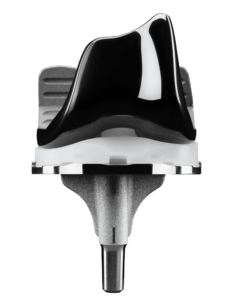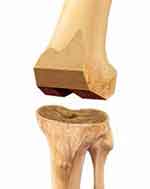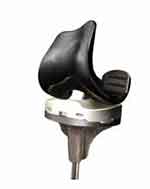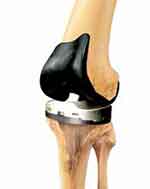The JOURNEY II BCS Knee
Recent advances in biomedical engineering software have opened a new chapter on high performance knee implants.
The tibial component has two elements – a metal base and a plastic insert – and replaces and the top of the tibia (shin bone). This prosthesis is made up of a metal tray attached directly to the bone and a high-density plastic spacer that provides the bearing surface.
The femoral component replaces the bottom of the thigh bone or femur. This component also replaces the groove where the patella or kneecap rides.
The patellar component replaces the surface of the knee cap, which rubs against the femur. The patella protects the joint, and the resurfaced patellar button will slide smoothly on the front of the joint. In some cases, surgeons do not resurface the patella.

Bearing Surfaces
One of the keys to a successful implant is its ability to withstand the rigors of daily activity, and central to that is the quality of the artificial surfaces that slide against each other, or articulate, in the new joint.
In knee implants, bearing surface options have been somewhat limited over the last few decades. The standard substance used for the femoral component is cobalt chrome, a metal alloy typified by its toughness and biocompatibility. However,even this high-quality industry standard has its shortcomings. Over time, this metal surface can become roughened by bone and bone cement particles trapped between the femoral component and the plastic tibial insert.
This roughened surface, when rubbing against the plastic component up to two million times per year, can more quickly wear out your implant. When that happens, you will have to undergo surgery to replace the plastic piece, the femoral component, and possibly even the tibial component. For this reason, implants have been shown to last between ten and fifteen years in the human body.
An exciting material to enter orthopaedics in recent years is OXINIUM◊ Oxidized Zirconium. This remarkable material combines the strengths of ceramic and metal, such as wear-reduction and strength, but does not have the weaknesses, such as limited implant options and the possibility of fracture.
Zirconium is a biocompatible metal, similar to titanium. When the zirconium alloy undergoes a unique heating process, the surface of the metal transforms into a ceramic. Even though the new ceramic surface is 4,900 times more abrasion resistant than cobalt chrome, it retains the toughness and flexibility of the underlying metal.
Because it can achieve this remarkable reduction in implant wear without sacrificing strength as actual ceramic components do, oxidized zirconium implants have the potential to last significantly longer.
The Procedure
Knee replacement surgery typically takes between one and two hours to complete. This section will provide you with a brief, easy-to-understand description of the surgical procedure. (Please consult with your physician for details regarding your specific procedure.)
- An incision is made extending from the thigh, past the inside edge of the kneecap, and down to the shinbone.
- The end of the femur is shaped in preparation for sizing the femoral trial component.
- The top of the tibia is shaped for proper sizing of the tibial trial component.
- The trial units are put in place and the appropriate implant size is selected.
- The knee is assessed for alignment, stability, and range of motion.
- The underside of the kneecap is prepared and patella trial is selected.
- The trial units are removed and the final femoral, tibial, and patella components are implanted.
- The incision is closed, a drain is put in, and the post-operative bandaging is applied.
All information provided on this website is for information purposes only. Every patient’s case is unique and each patient should follow his or her doctor’s specific instructions. Please discuss nutrition, medication and treatment options with your doctor to make sure you are getting the proper care for your particular situation. If you are seeking this information in an emergency situation, please call 911 and seek emergency help.
All materials copyright © 2020 Smith & Nephew, All Rights Reserved.

Bone Cuts

Implant Components

Implanted

